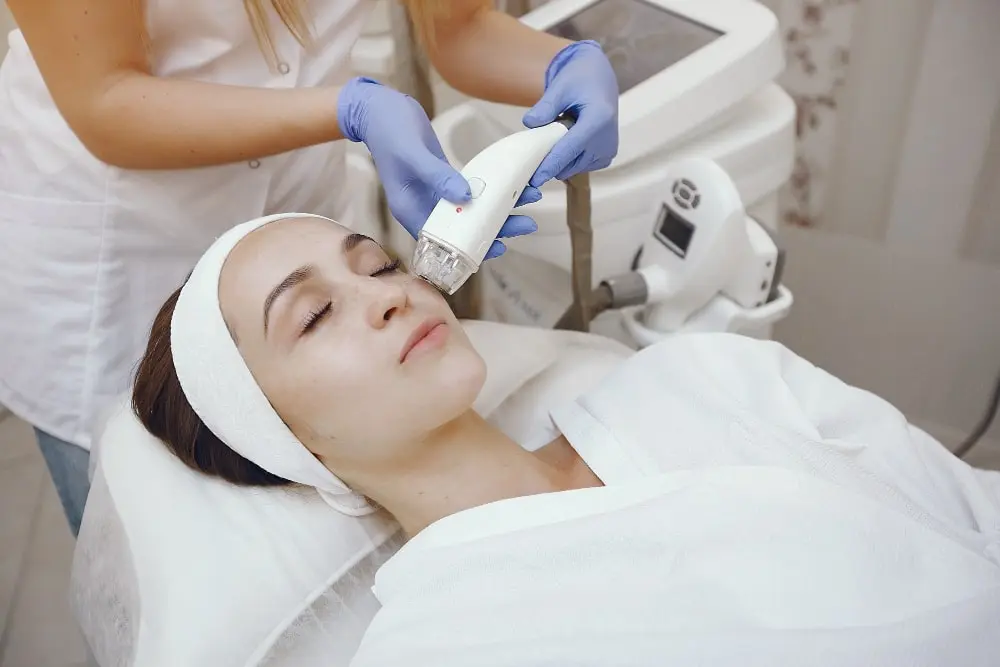Achieving clear, flawless skin can be a challenge for those struggling with pigmentation issues like dark spots or melasma. Fortunately, advancements in laser technology offer promising solutions to address these concerns, often delivering quick and precise results. Suppose you want to achieve radiant, even-toned skin.
In that case, this comprehensive guide by Eve On 21 will walk you through everything you need about the best laser treatment for pigmentation, from understanding the root cause of pigmentation to choosing the proper treatment for your skin.
Understanding Skin Pigmentation
Pigmentation is a common skin concern that results in areas of the skin becoming darker than the surrounding tissue. This darkening occurs due to an overproduction of melanin, the natural pigment responsible for skin colour. While pigmentation is not harmful, many people seek treatments to get unwanted pigmentation or reduce its appearance for cosmetic reasons.
Common Causes of Pigmentation
Several factors contribute to the development of pigmentation, including:
- Sun Exposure: Overexposure to UV rays is the leading cause of hyperpigmentation, resulting in sunspots, freckles, and age spots.
- Hormonal Changes: Conditions like melasma often appear during pregnancy or due to birth control use, as hormone fluctuations trigger excess melanin production.
- Aging: As the skin ages, it becomes more susceptible to uneven pigmentation due to the cumulative effect of sun damage and slower cell turnover.
- Inflammation or Injury: Acne scars, wounds, or skin conditions can lead to post-inflammatory hyperpigmentation.
Types of Pigmentation Issues Treated with Lasers
Different types of pigmentation can be treated effectively using laser technology. These include:
- Melasma: A form of pigmentation that appears as brown or grey patches, typically on the face.
- Sunspots/Freckles: Small, concentrated areas of pigmentation that result from prolonged sun exposure.
- Post-inflammatory Hyperpigmentation: Dark marks left after acne or skin injury.
What is Laser Treatment for Pigmentation?
Laser treatments for pigmentation use highly focused beams of light to target and break down melanin in the affected areas of the skin. These noninvasive treatments allow for precise pigmentation and removal without damaging surrounding tissue. The body’s immune system naturally absorbs and eliminates the fragmented melanin over time.

How Laser Treatments Work
Laser treatments emit a specific wavelength of light absorbed by the pigmented cells in the skin. This energy breaks the pigment into tiny particles, gradually absorbed and cleared away by the skin’s natural healing processes. This method helps lighten or remove areas of excess pigmentation, promoting a clearer complexion.
Benefits of Laser Treatments for Pigmentation
- Precision: Lasers can precisely target pigmented areas, reducing the risk of affecting surrounding healthy skin.
- Non-invasive: Laser treatments do not require surgical incisions, making the procedure relatively low-risk with minimal downtime.
- Effective on Various Skin Types: Advances in laser technology have made it safer for different skin tones and types.
Different Types of Laser Treatments for Pigmentation
There is no one-size-fits-all approach to treating pigmentation with lasers. Different laser technologies cater to varying levels of pigmentation severity and skin types. Here’s a breakdown of the most popular laser treatments for skin pigmentation treatment:
Q-Switched Lasers
Q-Switched lasers treat deep pigmentation, such as melasma and sunspots. These lasers emit high-energy light in short pulses, effectively targeting deeper layers of the skin without harming the surface or surrounding skin.
- Best for Melasma, sunspots, and post-inflammatory pigmentation.
Fractional CO2 Laser
This laser is designed for more serious skin treatments, severe pigmentation issues and overall skin resurfacing. It creates microscopic skin wounds, triggering a healing process that stimulates collagen production and reduces pigmentation.
- Best for: Severe pigmentation, wrinkles, and skin texture improvements.
PicoSure Laser
PicoSure is one of the most advanced lasers for pigmentation removal treatment. It uses ultra-short energy pulses to break up pigmentation into smaller particles, making it easier for the body to eliminate. It typically requires fewer sessions than traditional lasers and offers quicker results.
- Best for: Faster results with fewer treatment sessions.
IPL (Intense Pulsed Light)
Though technically not a laser, IPL uses light energy to target pigmentation. It’s best suited for milder pigmentation issues such as freckles, sunspots and overall uneven skin tone for improvement.
- Best for: Milder pigmentation and sunspots.
Who is a Good Candidate for Laser Treatment?
Laser treatment can offer remarkable results, but not everyone is an ideal candidate. Several factors can determine whether you’re suited for laser treatment.

- Skin Type: Those with lighter skin tones generally see faster results with fewer risks of side effects, although newer laser technologies are also safe for darker skin tones.
- Type and Severity of Pigmentation: Deeper pigmentation, such as melasma, may require different lasers than surface-level sunspots.
- Medical History: It’s essential to disclose any underlying health conditions or medications you’re taking, as certain factors can impact healing.
Consulting with a licensed dermatologist is essential to assess your suitability for laser treatment and determine the best approach for your skin.
What to Expect During a Laser Treatment Session
Laser treatments for pigmentation are usually quick and involve minimal discomfort. Here’s a step-by-step guide on what to expect during a typical laser treatment session:
- Consultation: A thorough skin analysis is performed to identify the type and depth of pigmentation.
- Preparation: The treatment area is cleansed; sometimes, a numbing cream may be applied to reduce discomfort.
- Laser Application: The laser device is passed over the treatment area. You might feel a mild stinging or warming sensation as the laser pulses hit the skin.
- Duration: A typical session lasts anywhere from 20 to 60 minutes, depending on the size of the treatment area.
- Post-Treatment: After the procedure, a soothing gel or cold compress may be applied to reduce immediate redness or irritation.
Post-Treatment Care for Optimal Results
Aftercare is crucial to achieving the best results from laser treatments. Proper post-treatment care ensures the skin heals effectively and prevents complications such as infection or further serious skin pigmentation problems or issues.
Aftercare Tips
- Hydration: Keep your skin well-moisturised to support the healing process.
- Sun Protection: Avoid direct sun exposure, and always wear sunscreen with a high SPF to protect your treated skin from UV damage.
- Avoid Harsh Products: Skip exfoliants, retinoids, or any harsh skincare products until your skin has fully healed.
Possible Side Effects
Common side effects after laser treatment may include:
- Redness or swelling: These usually subside within a few hours or days.
- Peeling or flaking: Some patients experience mild peeling as the skin regenerates.
Benefits of Laser Treatment for Pigmentation
Laser skin treatments offer several advantages over traditional pigmentation treatments like creams or chemical peels.
- Quick Results: Many patients see significant improvements after just one session, with continued improvements.
- Precision: Lasers can target specific areas of pigmentation without affecting surrounding healthy skin.
- Minimal Downtime: Most laser treatments involve little to no recovery time, allowing patients to resume their normal activities quickly.
Are There Any Risks or Side Effects?
While laser treatments for pigmentation are generally safe, there are some potential risks to be aware of:
- Temporary Redness and Swelling: Mild swelling or redness is common but typically subsides within a few hours.
- Hyperpigmentation or Hypopigmentation: In rare cases, laser treatments may cause darkening or lightening of the skin, especially in those with darker skin tones.
Always choose a qualified, experienced professional for your laser treatment to minimise these risks.
How to Choose the Right Laser Treatment for You
With many options, selecting the best laser treatment for pigmentation can be overwhelming. To make an informed decision, consider the following factors:
- Skin Type: Certain lasers are better suited for specific skin types. For example, Q-switched lasers are ideal for deeper pigmentation, while IPL is better for surface-level concerns.
- Pigmentation Type: Your dermatologist will recommend the type of laser treatment for your pigmentation based on its depth and severity.
- Consultation with a Professional: Consult a licensed dermatologist or skincare professional who can tailor the treatment to your needs.
Conclusion
Laser treatments for pigmentation offer an effective solution for those seeking to improve the appearance of dark spots, melasma, and other pigmentation concerns. With various options available, you must consult a qualified dermatologist to determine the best laser pigmentation treatment for your unique skin type and concerns. Ready to take the first step toward flawless, even-toned skin?
Book a consultation today and discover the transformative effects of the best laser treatment for pigmentation.
Frequently Asked Questions(FAQs)
Can Laser Improve Hyperpigmentation?
Yes, laser treatments can effectively reduce hyperpigmentation by targeting and breaking down excess melanin in the skin. Different lasers, such as Q-Switched and PicoSure, are used based on skin needling and the severity of the pigmentation. Many patients notice visible improvements after just a few sessions.
Are There Any Side Effects Of Laser Treatment For Pigmentation?
Common side effects include temporary redness, swelling, and mild peeling, which usually resolve within a few days. In rare cases, patients may experience hyperpigmentation (darkening) or hypopigmentation (lightening) of the treated skin cells. Proper aftercare and treatment by an experienced professional minimise these risks.
How Do You Prevent Hyperpigmentation After Laser?
To prevent hyperpigmentation after laser treatment, proper aftercare is essential. Key measures include:
- Sun Protection: Avoid direct sunlight and always use a high-SPF sunscreen (SPF 30 or higher). UV exposure can worsen pigmentation and delay healing.
- Moisturisation: To promote healing, keep the treated skin hydrated with gentle, fragrance-free moisturisers.
- Avoid Harsh Products: Do not use exfoliants, retinoids, or other potentially irritating skincare products until the skin has fully healed.
- Follow Professional Advice: Follow all your dermatologist’s post-treatment instructions to minimise the risk of complications or pigment changes.
How Long Does Laser Treatment For Pigmentation Take To Heal?
Healing time for most laser pigmentation removal treatments generally takes 5 to 7 days, though more intensive treatments like Fractional CO2 lasers may take up to 10 days. During this time, the treated area may darken before fading as the skin regenerates. Redness and swelling are common but usually subside within a few days.
How Often Do You Need A Laser For Pigmentation?
The frequency of laser sessions depends on the type and depth of pigmentation being treated. Most patients require 3 to 6 sessions spaced 4 to 6 weeks apart for optimal results. Your dermatologist will assess your skin and create a treatment plan tailored to your needs.




